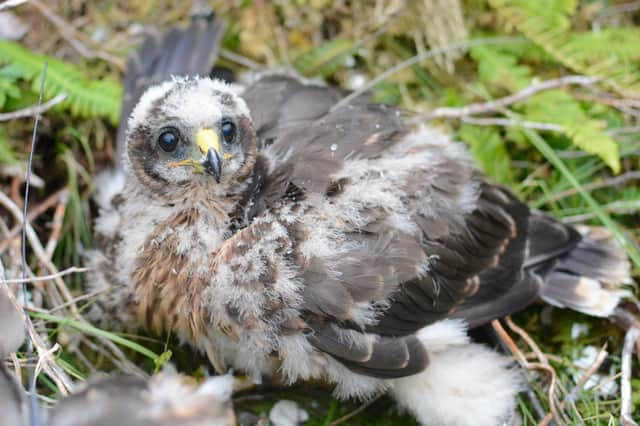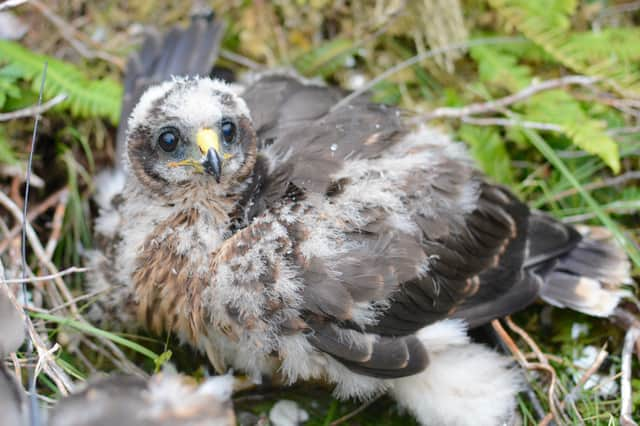Hen harriers: Wild Isles star species live just 121 days after leaving nest - with illegal killing a key cause


Hen harriers are of the UK's birds most at risk of disappearing forever, but a new study shows that the number one cause of death for adults is being illegally killed - and sometimes even mutilated.
The research, published on Thursday (10 May) by the Royal Society for the Protection of Birds (RSPB), also found that mortality due to illegal killing was highest in areas managed for hunters to shoot red grouse. Using data from what is said to be the largest GPS tracking programme for hen harriers globally, the authors discovered that individuals tracked by the project were typically living for just 121 days after fledging.
Advertisement
Hide AdAdvertisement
Hide AdThey also found that if the birds hunted in grouse moors just 10% more often, their mortality rate shot up 43%. RSPB estimates there are now less than 600 breeding pairs of the predatory birds left, and they have a UK conservation status of red - meaning the species is in critical decline.
Their last stronghold is Scotland - namely Orkney and the Hebrides, where around 80% of the remaining population can be found.


RSPB senior conservation scientist and study lead author Steven Ewing said that it has been illegal to kill hen harriers for nearly 70 years now. "But this study adds to the already overwhelming evidence base that illegal killing on grouse moors remains a key cause of this species’ low population size, and its ongoing absence from large areas of the uplands, particularly grouse moors.”
For the new study, published in science journal Biological Conservation, researchers used satellite tracking devices to look into the survival and movements of hen harriers. Between 2014 and 2020, satellite transmitters were fitted to 148 juvenile hen harriers at nests across Scotland, England, Wales, and the Isle of Man.
Advertisement
Hide AdAdvertisement
Hide AdThe scientists looked at their survival rates and their causes of death - including whether it was natural or they had been killed - as well as whether there was a link between death rates and land managed for grouse shooting.
For young birds less than one year old, illegal killing accounting between 27 to 41% of deaths, while it made up a whopping 75% for birds aged between one and two years. Not enough birds survived more than two years to estimate mortality due to illegal killing of adults.
Duncan Orr-Ewing, head of species and land management at RSPB Scotland, said the study reinforced the "devastating impact" illegal killing was having on the hen harrier population, as well as "how strongly it is associated with grouse moors, and why urgent changes are needed to bring this to an end".
“There should be three times as many breeding pairs of hen harriers in Scotland than we currently have.
Advertisement
Hide AdAdvertisement
Hide AdHe said thankfully, the Scottish Government has undertaken an independent review of the evidence and is considering action. “It is proposing to license grouse shooting with sanctions including the removal of the right to shoot grouse where wildlife crimes are confirmed, and to provide a meaningful deterrent to wildlife crime."
RSPB plans to to give evidence to the Rural Affairs and Islands Committee of the Scottish Parliament when it considers the draft wildlife management and muirburn bill in the near future. Mr Orr-Ewing added: “The illegal killing of hen harriers and other birds of prey has no place in the nature and climate emergency and must end.”
The species was recently featured in the 'grasslands' episode of David Attenborough's Wild Isles series. But there have been a number of high profile incidents where hen harriers have been killed or mutilated, one just a week ago.
The Yorkshire Post reports a male hen harrier's body was discovered in the area near Birkdale in the Yorkshire Dales, with its head and leg removed. He was a tagged hen harrier named Free, and expert veterinary assessment concluded he was killed through traumatic removal of his head and leg, whille still alive.
Twenty other harriers, including 15 birds that were part of satellite-tagged tracking projects, have also disappeared across Northern England alone in the past year.
Comment Guidelines
National World encourages reader discussion on our stories. User feedback, insights and back-and-forth exchanges add a rich layer of context to reporting. Please review our Community Guidelines before commenting.
